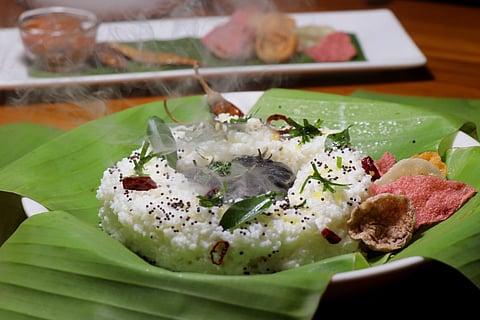

Curd rice is an emotion, at least for a section of south Indians. A humble dish in the defence of which ardent fans could willingly go to war. Known as mosaranna or thayir sadam in local parlance, it is an essential, in fact mandatory, part of all meals for many in the south. But here is a curd rice dish that could pique the curiosity of even those who aren’t the biggest fans of the comfort food. It is curd rice that is smoked with a piece of heated stone in the centre – in plain terms, a curd rice sizzler. Yes, you read that right!
Just a couple of years ago, a team of food lovers, travellers, and chefs had stumbled upon the ‘curd rice sizzler’ in the Banavasi region in Uttara Kannada. The group was commissioned by Total Environment Hospitality to travel across Karnataka, document the journey and collect authentic recipes for Oota, a novel yet traditional restaurant in Bengaluru’s Whitefield, that prides itself in serving authentic Karnataka dishes. Time after time, the restaurant has churned out masterpieces like ‘ragi manni’ and ‘bale hannu halwa’. The latest addition to their extensive menu is this curd rice with a twist, taken to the next level with the mere addition of a sizzling kal (stone) in the centre and some oggarane (tempering). Referred to as ‘kalbutthi’, the dish is a common feature in the meals of the Konkanastha Chitpavan Brahmin community.
In 2014-15, veteran travel/food writers and husband-wife duo Anurag Mallick and Priya Ganapathy ventured out on the journey of a lifetime — one that covered 20,000 kilometres, lasted over two-and-a-half years, and spanned across the length and breadth of Karnataka. Accompanying them were chefs Suresh Venkatramana, Manjit Singh, and a team of videographers. The goal? To discover and cook with the local flavours of the state.
During their journey in Banavasi, the ancient capital of the Kadamba dynasty known for its juicy pineapples and the majestic Madhukeshwara Temple, the food-lovers’ squad came across a special form of curd rice — a staple in the region yet unheard of outside. “One of the local residents took us to his ajji (grandmother), a woman named Indira Phadke, who had prepared a spread of delicacies associated with the Chitpavan or Konkanastha Brahmin community. This community is said to have been around in Banavasi for 400 years,” reminisces Anurag.

(From left) Chef Manjit Singh, Indira Phadke, and Priya Ganapathy
Several dishes were served to the group, including the pineapple gojju made using the famed Banavasi pineapples. “But in the end, we were given a dish wherein she mixed rice and curd, heated a stone in the fire and dusted it, and then put the stone into the mixture. She then prepared a tempering with ghee, curry leaves, and mustard seeds, and poured it over the stone. We tasted it and it had a lovely, smoky flavour. It was rustic, simple. Yet its essence was so exciting,” Anurag says.
.jpg?w=640&auto=format%2Ccompress)
Homemade kalbutthi served by Indira Phadke
Mrs Phadke, 70 years old at the time, also revealed to the team that it was not enough to prepare a batch of curd rice with one large hot stone. Each child in the household demanded an individual stone of their own!
As years went by, the team did several trials of the dish. But it eventually became a forgotten affair, especially post Covid. This year, however, along with its corporate chef Maandaar Sukhtankar, Oota decided to revive the dish and plate it in a traditional yet contemporary manner — curd rice with a piece of hot stone dropped in the centre, concealed with the rice, wrapped in a banana leaf, and kept under a cloche to ensure that the smoke coming out of the coal doesn’t escape, infusing a smoky aroma into the dish.
To take it up a notch, the team set the curd in earthen containers and flavoured it with Gokarna’s Sanikatta salt. “We were inspired by the extremely delicious ‘matka dahi’ that we had at Korthi-Kolhar near the Almatti Dam on the Bagalkot-Bijapur Highway. This is made from the great quality milk produced by the region’s buffaloes which feed on the grass near the dam. The dish is usually consumed with avalakki (flattened rice), putani pudi (chutney powder), or shenga (peanut) chutney,” he says.

Matka dahi at Korthi-Kolhar

Avalakki with putani pudi
When the Oota team shared a reel of the making of ‘kalbutthi’ on Instagram, it went on to garner more than half a million views, even paving way to a curd rice discourse on social media. While some were outraged by the idea of a ‘hot’ curd rice, some felt nostalgic and recalled their grannies making the dish.
And this is exactly what the team wanted — to start an engaging conversation about legacy recipes. “Just like how we have moved from Indian to Western attire, our diet has become more global too. During our travels, we heard even women from small towns such as Dharwad, Bijapur, and Davanagere lament that today’s kids prefer fast food items such as burgers and pastas. So we are glad to shine some focus on traditional cuisine and revive some of these lost recipes. We will continue to safeguard these heirloom recipes through seasons and communities,” says Anurag.
‘Kalbutthi’ is available at Oota, Whitefield, Bengaluru. For reservations, call 88802 33322.
Deepa Natarajan Lobo is an independent journalist and content writer from Bengaluru with over 15 years of experience in the field of media and writing. She writes on a broad range of topics like human interest, lifestyle, food, art & culture, and entertainment among others, and has also edited two books.
Images by Anurag Mallick/Priya Ganapathy.